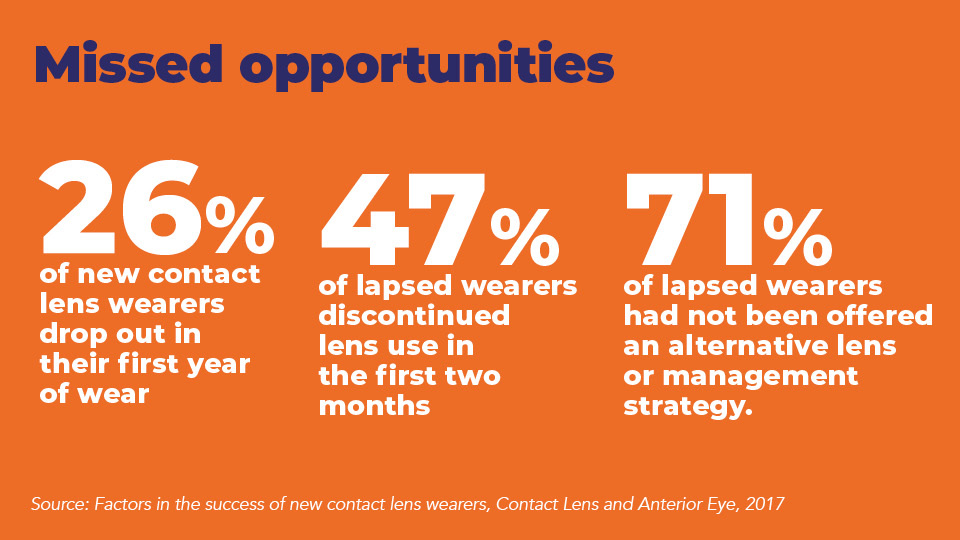- OT
- Industry
- Contact lenses
- Contact lenses in focus
Practice team guide
Contact lenses in focus
From first teach to talking with patients about upgrades, OT finds out how the practice team can keep patients happy in contact lenses

06 October 2023
The whole practice team has a role to play when it comes to introducing patients to contact lenses – and ensuring the satisfaction of existing wearers.
Once a patient is wearing contact lenses, all team members can support ongoing wear by being conscious of signals – whether obvious or subtle – that a patient may need extra support or benefit from an updated lens.
For tips on the hallmarks of a successful contact lens teach, OT approached optometrist and Johnson & Johnson Vision professional affairs consultant, Robyn Marsden, for her thoughts.
The contact lens teach
Marsden, who has worked in both multiple and independent practices, shared that a good contact lens teach starts with the right environment.She recommends a clean, light space, with consideration given to privacy.

A patient may feel anxious about the experience – and this could be exacerbated if they feel that there could be an audience to them learning this new skill.
“A patient should also not feel rushed, and it should be clear to them from the outset that a teach can take more than one appointment to ensure that their technique is correct,” Marsden said.
She added that this approach means a patient receives a boost if they master application and removal in the first session ¬– but if not, they know it is normal and avoid a blow to their confidence.
Marsden finds it helpful to send patients links to application and removal videos in the days leading up to the appointment.
I believe the key to a successful contact lens teach is the empathy and encouragement shown by the teacher
She shared the importance of adapting the application and removal process to suit the patient in the chair.
“Sometimes something as simple as changing the position of the mirror or adapting which fingers a patient uses can make all the difference to their success,” Marsden said.
In terms of keeping the patient engaged, it can help to remind them of the reasons that they decided to try contact lenses – for example, mentioning a sport that they can look forward to playing spectacle-free.
“I believe the key to a successful contact lens teach is the empathy and encouragement shown by the teacher,” Marsden emphasised.
Providing simple explanations and clear technique amendments can have a “real impact” on the results achieved, she added.
Once a patient’s contact lens application and removal technique is safe and they are ready to take their lenses home, Marsden highlighted that it is vital that they understand how to care for their lenses. Written information can be provided for the patient to take home.
Marsden shared that patients should be encouraged to contact the practice if they encounter any difficulties at all.
Upskilling on upgrades
Reflecting on upgrades, Marsden shared that offering a different contact lens option to patients can be perceived as ‘selling’ by some practitioners.“I see offering upgrades to patients as a duty and a chance to keep them informed, which adds value to my aftercare whilst maintaining patient happiness and loyalty,” Marsden highlighted.
Conducting a thorough history and symptoms during a patient’s aftercare appointment can help to establish if a patient is in the right contact lens.
Turning to tell-tale signs that a patient may be struggling with their lenses, Marsden points to reduced wear time or a patient who asks to pause their direct debit because they have a number of unworn lenses at home
Marsden will ask patients to rate their comfort and vision out of 10 both at the start of the day and the end of their wear time. If the patient reports any number below 10, Marsden will ask what needs to be different to achieve a perfect score.
“An open question like this often tells me so much,” she said.
When offering a patient an upgrade, Marsden will begin by saying that the contact lens they are wearing is good but if she was fitting them for the first time today she would have selected an alternative lens.
“I then follow with an explanation of the benefits they would gain from the upgraded material or design,” she highlighted.
When addressing cost, Marsden breaks down any increase to the additional cost per wear – which may only be a few pence per day.
Follow up
Marsden highlighted that around one in four people who try wearing contact lenses discontinue wear in the first year.
Keeping this statistic in mind, Marsden emphasised the importance of engaging with the patient during their trial.
Common reasons for drop out include handling difficulties, issues with dryness or discomfort and vision not meeting expectations.
Marsden shared that she finds it helpful to assign each new contact lens wearer to a member of the practice team, who can work with them from teach through to sign up.
“Support from the practice team both during the trial and in the early weeks post-trial can make a big difference,” she said.
“This ensures patients feel supported, are reminded about what motivated them to try contact lenses and ultimately means we keep more patients happy,” Marsden emphasised.

Building confidence in contact lenses
Johnson & Johnson Vision has a series of online resources that can help patients become confident in their contact lens routine. Resources include videos of real contact lens wearers applying and removing lenses – a useful reminder of the correct technique for patients during their at home trial period.


Comments (0)
You must be logged in to join the discussion. Log in